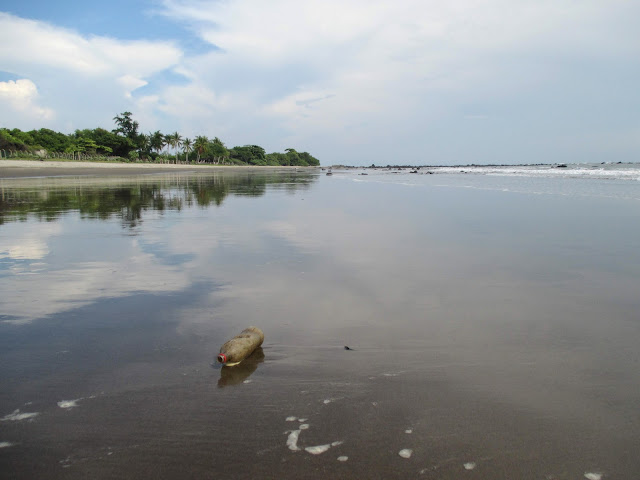What Happens if the Beach Turns into Plastic?
Beaches in El Salvador have a pretty good reputation for being trashy. Certainly 20 years ago, beach-goers routinely tossed their trash into the water or left anything that was not going home right there on the sand. After any holiday, The warm black sand was literally covered with paper napkins, styrofoam plates, plastic forks, straws, plastic bags, and all kinds of picnic garbage. Roaming dogs ate the food scraps. Stuff worth selling was picked up by scrappers and recyclers. And people relied on the waves to wash the bulk of the trash out to sea.
And while trashing the beach while at the beach was bad enough, tossing stuff out of bus windows, sweeping home trash into the streets, tossing rural trash into water ways was simply what Salvadorans did. The challenge was real, and still is: small country, big population, an abundance of trash.
Over the last 20 years, environmental education combined with infrastructure improvements have made a big difference in the level of trash-tossing throughout El Salvador. Still, littering happens, as does dumping of trash along roadsides when there simply is no place else to put trash. Frequent street floods during the rainy season and lack of stormwater management systems in general still cause garbage to make its way to streams and rivers and eventually out to sea.
What is true for El Salvador is true around the world. Environmental scientists have created video documentation of great islands of plastic in the ocean. We can read warnings about micro-plastics inside of marine life and in the water we drink. Yet for many who put their garbage cans out on Monday mornings and find that the trash has magically disappeared by Monday afternoons, decisions about plastic and other waste may not be taken seriously. It is difficult to believe that the green top on my gallon of milk. which I toss into a tall kitchen garbage bag, which gets hauled away and put somewhere I do not see, might have an impact on a beach thousands of miles away from where I live.
This week, we went to a beach - a very isolated and clean beach near the far eastern edge of El Salvador. At low tide, a wide expanse of sand opens up: sand that appears beautifully clean. I would say it is the cleanest beach I have ever seen in El Salvador. Of course, like anyone does at the beach, I took photos. As you look at these photos, dear readers, think about the most beautiful beaches you have visited in person, or via magazines or the internet or movies. Those beaches are ALL being taken over by plastic. We cannot be fooled into thinking that we have done enough because we have lessened the obvious trashing of our beaches by eliminating litter. We also cannot blame small, densely populated countries like El Salvador for the plastification of our planet's oceans. This is a global problem which requires attention at all levels from production to consumption.
So, dear readers, take a look at the details in these photos. Maybe they will inspire you to make one small change in your purchasing practices. Maybe you will be inspired to clean up the streets on your block. Maybe you will be inspired to demand responsibly packaged goods from producers in your city or state. Maybe you will be inspired to dig into the question, what happens if the beach turns into plastic.
 |
| As the tide receded, a thin coat of water created a mirrored surface over the sand. Breaks in the reflection reveal gifts deposited on the shore by the movement of the sea. |
 |
| While you can easily identify some items in this photograph, zoom in even closer to see how the action of the wind, the waves and the sand break plastic into smaller and smaller pieces over time. |
 |
| At low tide, the remnant of an ancient lava flow emerges from beneath the water. The rocks are a haven for birds, barnacles and other things that get caught up among them. |
 |
| This is a plastic water bottle. How many years has it traveled? How far did it go? Where did all the missing pieces end up? |
 |
| This is a gift from Mother Nature. This is not trash on the beach. It is a very large sponge. |
 |
| Straw from a juice box or pouch drink. Straws are everywhere. |
 |
| Zoom in. What do you see? |
 |
| Look very carefully. The trash in this photo is becoming one with the sea bed. This is a small tidal pool. |





Comments
Post a Comment